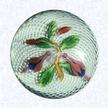Other Techniques - Latticinio

Fuschia Bouquet on
White Latticinio
Saint Louis, circa 1845-55Latticiniov
A glassmaking technique frequently used in paperweightmaking is latticinio or latticino (Italian for milk food). Originally an ancient Roman technique, it was later perfected in Venice during the sixteenth century. By the end of the eighteenth century, however, the latticinio technique was no longer is use; the method of its creation was lost.
The technique was rediscovered in the next century, shortly before the first paperweights were produced. Latticinio backgrounds were made by "collapsing" a filigree rod. A filigree rod was made by arranging thin rods of white or color upright in a mold, plunging a gather of molten glass into the mold, and attaching a second pontil rod so that the gather could be stretched and twisted to make a cane. Short lengths of fine latticinio were used as a filigree background (called upset muslin) for many designs. Other lengths were used as twisted ribs in crown weights, and as torsades (an opaque thread loosely woven around a core of filigree, usually on a mushroom weight).
An important variation in the process of making latticinio produced a latticed ground. In creating this ground, a hollow, cylinder-shaped mold was lined with opaque threads of glass. A clear glass bubble was blown into the mold, picking up the threads. The bubble was then twisted and collapsed on itself, producing a flattened latticed glass disc. examples of this style are found in a Clichy weight and a Saint Louis weight in the collection.










